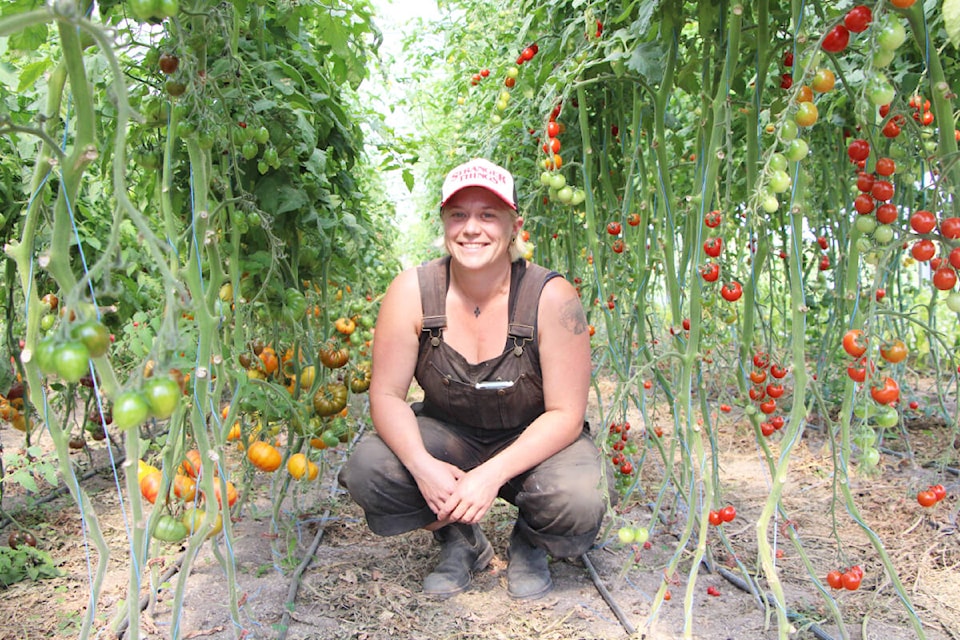Breaking into the wholesale market hasn’t been easy for Big Rock Ranch.
Even with a brand-new 100 by 32-foot industrial greenhouse, the ranch’s operators, Robin Hunt and Johan Bos, ran into several unexpected growing pains. A delayed growing season, inexperience working with a large greenhouse and the costs of shipping all combined to make this summer a busy one for both of them. Despite the setbacks, Hunt said she feels they’re on the right path.
“I think the switch to wholesale has allowed us to grow a larger amount of one product and to be able to ship it in mass bulk quantities,” Hunt said. “We harvest it quickly and move the product rather than going to a market and relying on weather and if people are in town.”
Rather than grow 45 different crops for market every week, Hunt said they now focus on a core group of cash crops. These include carrots, tomatoes, broccoli, cauliflower, zucchini, cucumbers, potatoes and garlic. They sell their vegetables to several different businesses including local grocers like Higher Ground Natural Foods and businesses in the Lower Mainland such as Discovery Organics.
This increase in volume is thanks largely to the greenhouse. Last year they had around an acre of arable land and with the inclusion of the greenhouse and several agricultural tunnels, they now have four acres. In the greenhouse alone, they have up to 1,600 tomato plants and 600 peppers.
“With the expansion of the greenhouse, it’s enabled us to double our production on our tomatoes,” Hunt said. “Moving our tomatoes to the new greenhouse has allowed us to double the production of our cucumbers, so we have an excessive amount of both.”
While the greenhouse has unquestionably been a smart investment, it brought its own challenges. The cost to set it up was significant, close to $30,000, and to make it happen Bos and Hunt were unable to hire any full-time farm hands this year. With most of their crops maturing late in the season, it’s been necessary for them to pull seven-day work weeks over the last month.
“The cold weather (in the spring) just meant it took a while to get the heat we needed to really start producing,” Bos said. “The crops all came out later and we didn’t have early crops like lettuce, so our cash flow also started later. That was stressful.”
Bos said the height of the greenhouse, 14 feet, allows some of the tomato plants to grow up to 12 feet tall. He said he now understands why a farming friend in Prince George walks around on stilts to harvest his crops.
“These are learning curve things you can’t really think through until you’re at that moment and go ‘oh the plant gets this big,” Bos said. “Now I need to bring a ladder for everything I do (in the greenhouse) and that slows you down.”
Hunt said she thinks they’ll stick to managing only one greenhouse for right now. Both she and Bos would advise fellow South Cariboo farmers who want to install their own industrial greenhouses to start with something manageable, such as a 10-foot by eight-foot structure.
Next year, Hunt said, they intend to start growing their produce in April so they can have tomatoes ready to sell by June rather than August. They also plan to apply for grants to bring on at least one field hand to reduce the workload on herself and Bos.
“We don’t make an income on our farm, it’s a very expensive hobby farm,” Hunt said. “That’s how it feels. We’re trying to make it successful in a lot of ways but it’s hard work, long days and it would be nice for people to realize what it actually takes.”
Hunt said the government could and should do more to support interior and northern farmers like herself. Infrastructure grants to help cover the cost of greenhouses would be one option, as would not closing off grants to those above the age of 30.
“Everyone should have a living wage and everyone, including the farmers, should have a guaranteed basic income. Having a guaranteed basic income for the farm workers and ourselves would be a game changer,” Hunt said. “I also think another big piece is having infrastructure support in regions like ours where we need the season extension (that greenhouses provide).”
